Many foods captivating Korean people’s taste buds have origins that can be traced to a specific traditional market. After gaining nationwide popularity, such local specialties take their place in mainstream Korean cuisine.
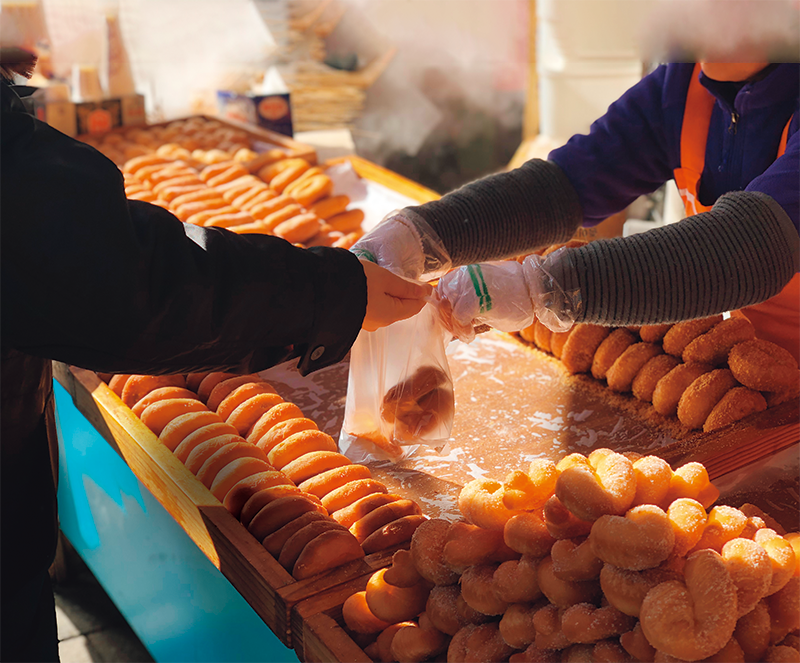
Popular market treats. Twisted donuts, or kkwabaegi, are made by kneading dough into a long rope shape, then folding and twisting it before frying it. Sweet red bean donuts are made by shaping the dough into a ball, filling the center with red bean paste and frying it.
© Shutterstock
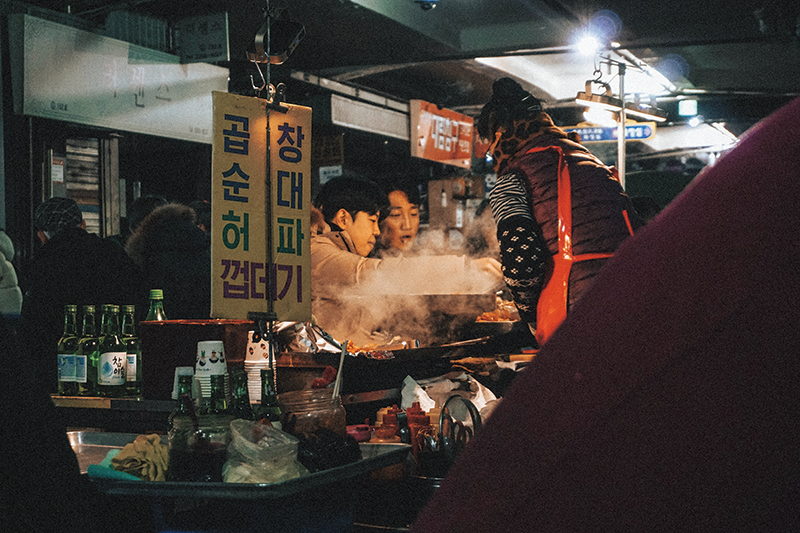
Market dishes tend to be cheaper and served in larger portions than at regular restaurants. The traditional market is a perfect place to have dinner and a drink to unwind after work.
Photo by Matt Rogers on Unsplash
In Korea, traditional markets are largely divided into two categories: large permanent markets like Seoul’s Namdaemun and Dongdaemun markets, and smaller temporary markets that open every three or five days and are called samiljang or oiljang, respectively. The latter flourished from the second half of the Joseon Dynasty (1392-1910), and their tradition continues today. On market days, the stalls are filled with regional produce and all kinds of culinary specialties. There is a vibrant energy in the air, with merchants coming and going, carrying goods, and shoppers everywhere. The permanent markets also bustle with life. Children who come holding their parents’ hands take with them a bagful of memories that they will cherish for a lifetime.
The highlight of traditional markets is without doubt the street food. Local specialties only available on market days or sold exclusively at specific markets often become famous by word of mouth. After going viral and gaining nationwide fame, they escape the confines of the local markets and spread to big cities, such as Seoul and Busan, and are sold across the country. Some famous regional delicacies that have their origins in traditional markets include Andong jjimdak (spicy braised chicken) from the Old Market in Andong, Jeonju kongnamul gukbap (soybean sprout soup and rice) from Nambu Market in Jeonju, Naju gomtang (beef bone soup), which several temporary markets in Naju claim as their own, and mulhoe (cold spicy raw fish soup) from Bukbu Market in Pohang.
JJIMDAK VS. FRIED CHICKEN
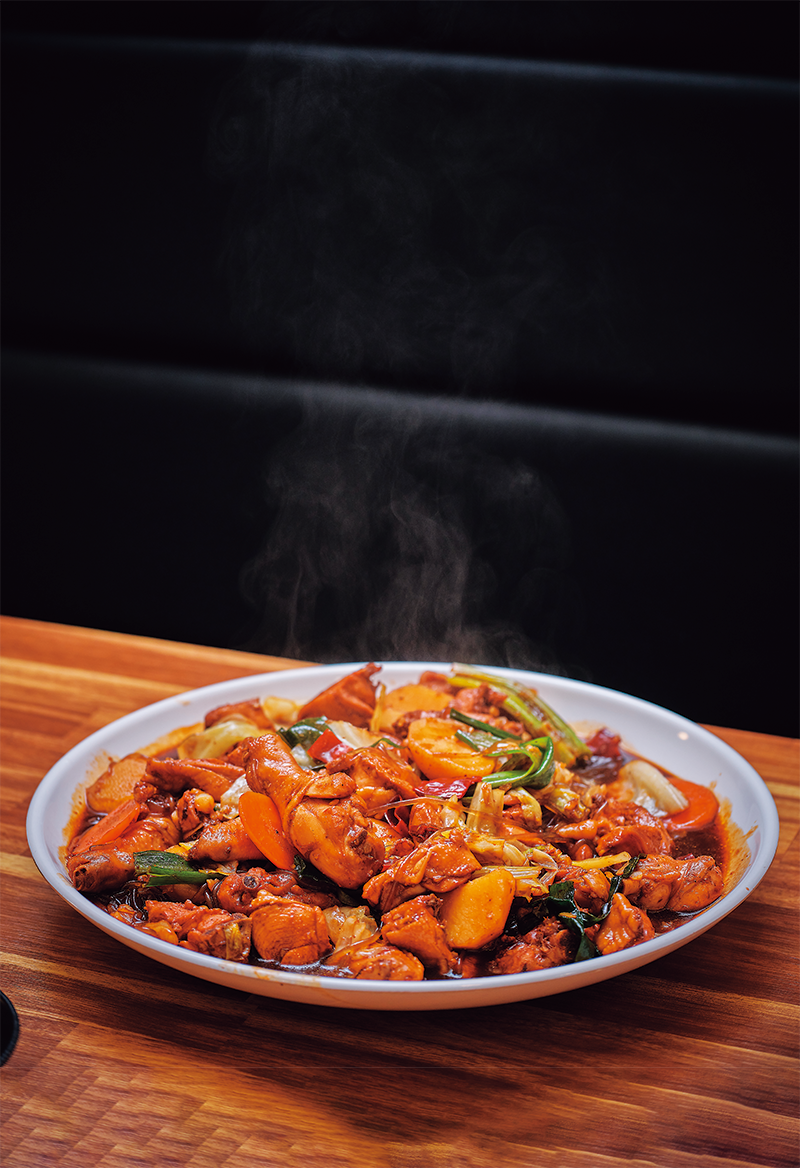
Andong has a long tradition of steamed dishes. Suunjapbang, a 16th-century cookbook that contains recipes for Andong’s regional specialties, features this braised soy sauce chicken dish. Andong jjimdak, originating from Andong’s Old Market, is a similar dish in which chicken is braised in soy sauce along with other ingredients.
© Studio KENN
Andong is a city in North Gyeongsang Province where traditional houses of noble families and seowon (private Confucian academies) from the Joseon Dynasty remain intact. To this day, there are many head families of clans who hold Confucian ancestral rites dozens of times a year. This is why, for a long time, Andong’s representative cuisine consisted of a wide variety of ritual food whose preparation was highly complex.
From the early 2000s, however, Andong jjimdak rose to the fore as the region’s signature dish. Having its origins at Andong’s Old Market, it is now a popular dish beloved nationwide. It is made by cutting chicken into small pieces and simmering it in a sauce with glass noodles and a variety of vegetables, including potatoes, carrots, cabbage, and shiitake. The ratio of the sauce’s ingredients is the key to the dish’s flavor: one cup of soy sauce, half a cup of starch syrup, one tablespoon of sugar, two teaspoons of minced garlic, one teaspoon of ginger, and a pinch of black pepper. Onions and scallions coated in aof flour batter help to intensify the flavor. The cooked vegetables add a sweetness to the dish, which offsets its spiciness. The rich textural contrast is a culinary delight. The crunchy vegetables, tender chicken, soft potatoes, and silky-smooth noodles come together in a delicious harmony of textures.
Up until the 1970s and 1980s, fried chicken shops flourished at the Old Market. However, records show that sales began to plummet when spicy chicken gained favor, so vendors developed the recipe for jjimdak to counter this downturn. Today, the dish enjoys nationwide fame, with tens of thousands of domestic and foreign tourists visiting the market to get a taste of the original Andong jjimdak.
HANGOVER SOUP
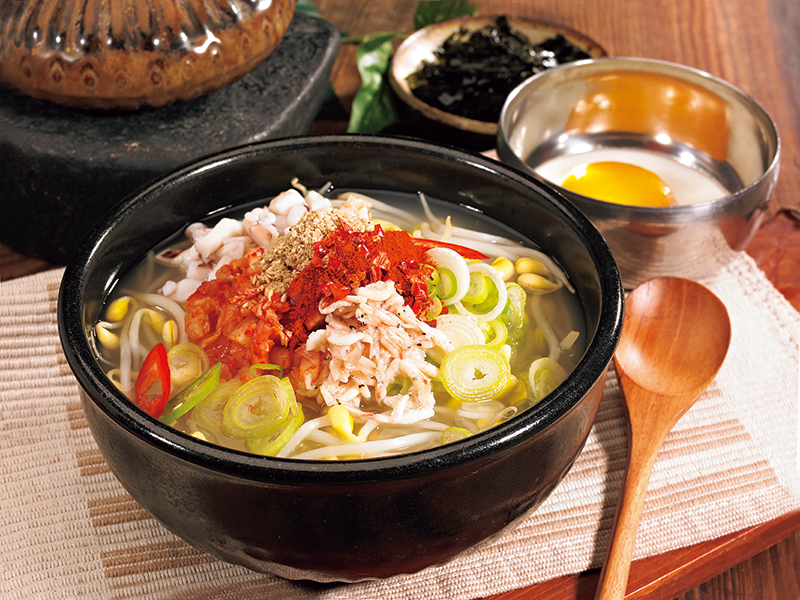
Alongside bibimbap, bean sprout soup is a famous delicacy from Jeonju. It is made by pouring hot meat broth over cold rice and blanched bean sprouts. The version of the dish sold at Jeonju’s Nambu Market is unique because it includes poached eggs served on the side like an appetizer. The dish is eaten by stirring the hot broth and sprinkling it with laver flakes.
© gettyimagesKOREA
Jeonju kongnamul gukbap is a hearty delicacy that hails from North Jeolla Province. The broth is made by first boiling dried anchovies in water, straining the anchovy stock, and then boiling soybean sprouts in it. Cooked rice, lightly blanched soybean sprouts seasoned with soy sauce, and salted fermented shrimp are then placed into the broth. Once the soup starts to boil, it is topped off with stir-fried kimchi, sesame salt, and red pepper powder.
Soybean sprout soup is known to have quite a long history, which is ed in Byeolgeongon (A Different World), a lifestyle magazine that was published from 1926 to 1934. But it was Jeonju’s Nambu Market that played a pivotal role in propelling the dish to the nationwide popularity it enjoys today. The market’s beginnings go as far back as the 1800s. In the 1960s, the building underwent a major refurbishment, resulting in the market’s current appearance. Jeonju was once the commercial center of the historical Jeolla Province. Hence, merchants from Gyeongsang Province, Chungcheong Province, and even as far as Jeju Island flocked to Nambu Market. When they were hungry, soybean sprout soup warmed their hearts and stomachs.
What is unique about the soup dish sold at Nambu Market is that it is served with suran (poached eggs) on the side. Suran is considered a traditional Korean delicacy thanks to how difficult it is to prepare just right. It is made by cracking an egg into a ladle and semi-submerging it in boiling water until just the egg white is cooked. Other than Nambu Market, it is difficult to find anywhere that serves suran with kongnamul gukbap. The dish’s mild, light flavor and the refreshingly hot broth that leaves beads of sweat on your forehead make this delicacy the perfect antidote for a hangover.
A NOURISHING DISH MADE WITH CARE
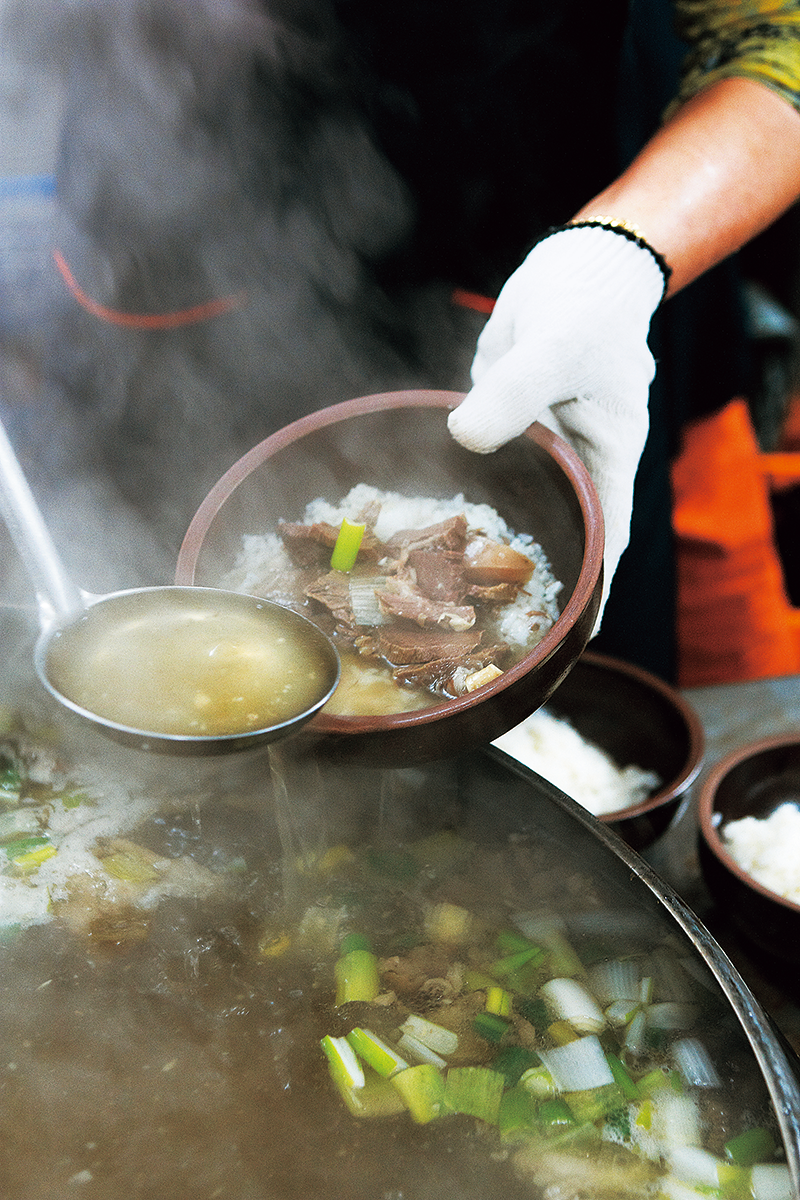
Hailing from Naju, gomtang includes a clear broth and generous portions of meat. It is also known for the distinctive method of heating the rice by pouring hot broth over it. Naju used to be the capital city of South Jeolla Province, and its market attracted merchants from across the country who would replenish their energy with a hearty bowl of beef bone soup.
© NewsBank
Gomtang is another heart-warming soul food popular with Koreans. When one is sick or lacking energy, beef bone soup is a common go-to dish. The ingrained belief is that a bowl of this hearty and highly nutritious soup provides the required boost of energy. Gomtang’s painstaking cooking process reveals the level of effort and care that goes into it. First, the beef is pre-cooked and seasoned along with mu, or Korean radish. It is then cut into pieces and simmered with a variety of vegetables, including scallions, typically for more than six hours. As the ingredients slowly boil together, their nutrients infuse into the broth.
The home of gomtang is Naju in South Jeolla Province, the birthplace of Korea’s oiljang. On market days, merchants from all over the country would fill their stomachs with a hot bowl of beef bone soup. The dish contained generous portions of leftover cuts of beef, such as offal and meat from the head, keeping its price reasonably low. The Naju region was a granary, with many families that raised cattle for farming. This naturally led to the development of the livestock industry, and the cow parts leftover after slaughter became the ingredients for gomtang.
Nowadays, however, gomtang is very rarely made with offal or leftover cuts of meat. Instead, most restaurants in Naju have turned to cuts of beef such as brisket, shank, or chuck roll, which are simmered in a broth made from leg bones. When the soup is paired with ripe kkakdugi (kimchi made with Korean radish), it represents the perfect dish to nourish both body and soul. The name gomtang refers to the way the dish is cooked. “Gomtang” is derived from the word “goda,” a verb which means “to simmer meat or bones in boiling water for a long time until the juice seeps out.” Time is the secret ingredient of this heart-warming soup.
THE FISHERMEN’S HUMBLE MEAL
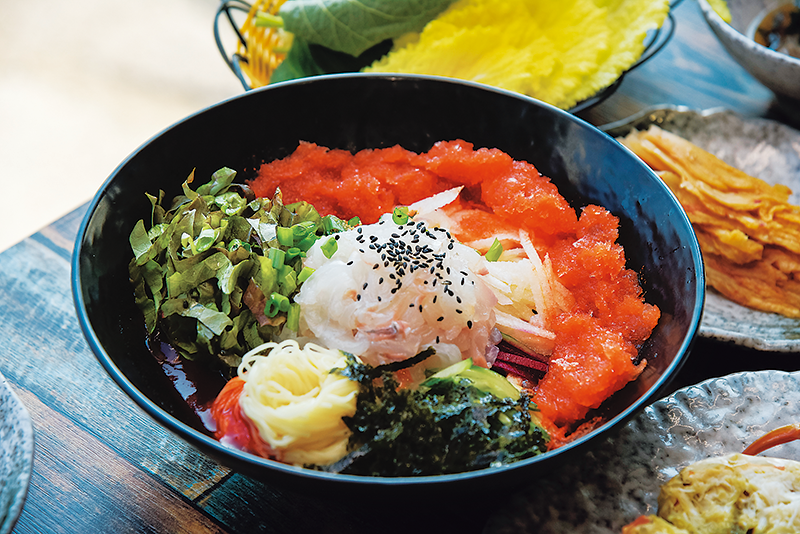
Mulhoe is made by mixing slices of raw fish, cooked rice, thinly sliced Asian pear, and vegetables in a bowl. After seasoning with red pepper paste, garlic, sugar, and sesame oil, ice water is poured over the mix. Located adjacent to the sea, Pohang’s Bukbu Market is known for the freshness of its raw fish dishes. The specialty mulhoe began to gain nationwide popularity in the 1980s.
© Korea Tourism Organization
Mulhoe is a specialty of Bukbu Market in Pohang, North Gyeongsang Province. It was originally enjoyed by fishermen out at sea who would make the dish with rice, a spicy sauce, and fish deemed too damaged to be sold. The humble dish can now be enjoyed all over Korea.
Having opened in 1967, Yeongnam Mulhoe is known to have first sold this simple fishermen’s meal. Thereafter, mulhoe spread throughout Pohang, and in the 1980s, it particularly flourished at Bukbu Market. Thick slices of raw fish, a generous helping of cooked rice, and thinly sliced cucumbers were mixed together in a bowl with red pepper paste. Later, water was poured into the bowl to scoop up the remainder of the dish. From the 1990s, rice was sometimes substituted with noodles. Although in the beginning, it was the norm to use white fish, some restaurants later replaced this with red fish, such as mackerel, while others sprinkled soybean powder over the dish in order to add a nutty flavor. In the 2000s, plain water was replaced with cold broth made with either plum extract or sugar, grated Asian pear or apple juice, and vinegar. With all the variations in flavor, mulhoe has become a summer delicacy beloved across Korea.
Park Mee-hyang Reporter, The Hankyoreh